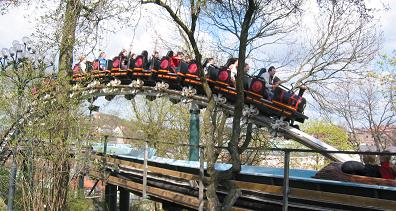
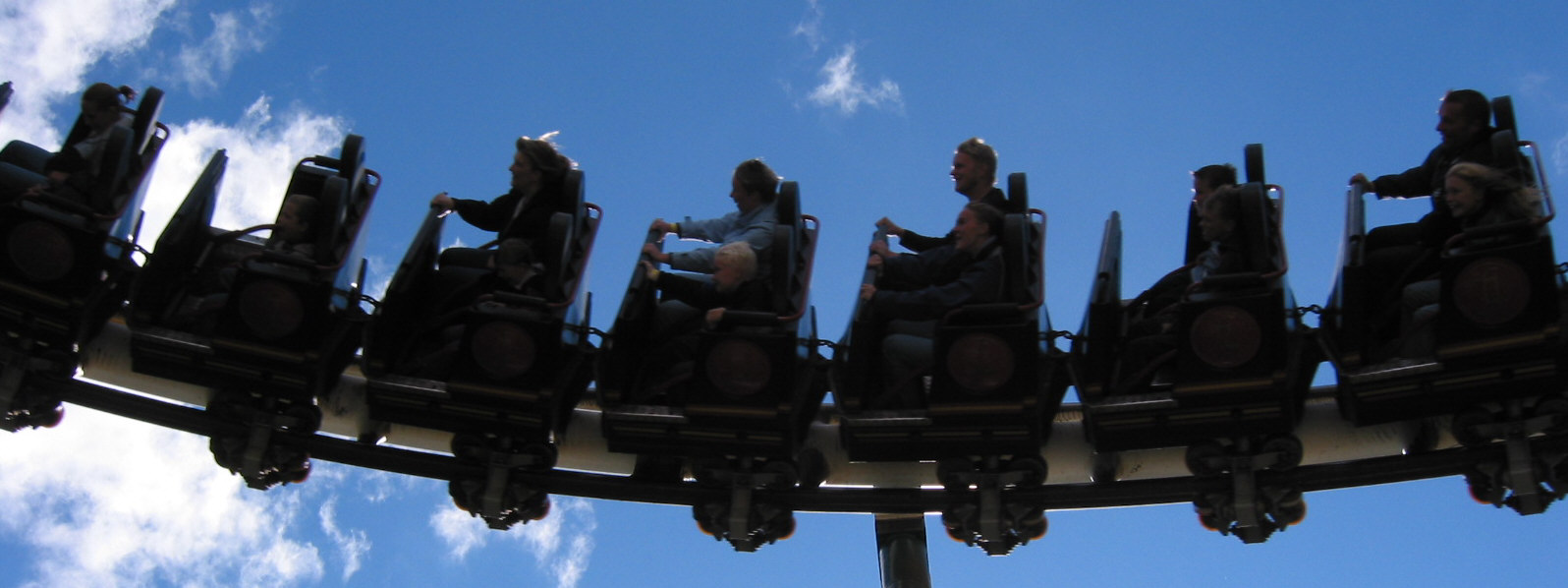
 When Liseberg opened for the world exhibit in 1923,
so did the classic wooden coaster, Bergbanan.
Fourty years later,
Werner Stengel started working on roller coasters together with
Anton Schwarzkopf. One of their first joint projects was the
first German steel roller coaster, Super Acht, which had its premier for
the Oktoberfest in Munich in 1964. In 1965, he visited Liseberg in
connection with the construction of a new roller coaster,
Super 8,
which operated from 1966 to 1979.
In 1980, the Super 8 was replaced by
LisebergsLoopen, which was
a copy of the first European looping coaster, the
Schwarzkopf/Stengel Looping Star, which
had its premier as a traveling version on German fairs.
LisebergsLoopen was the fourth of a total of 8 Looping Stars built. It
remained at Liseberg until 1995, when it was relocated to Brazil.
Werner Stengel also visited Liseberg in 1976 for the Children's coaster,
(Cirkusexpressen),
and in 1986 for Lisebergbanan, which opened in 1987, replaced the
old Bergbanan.
In addition to
coaster work, he also worked on e.g. the Ferris Wheel (Pariserhjulet)
and on the Wave Swinger (Slänggungan).
When Liseberg opened for the world exhibit in 1923,
so did the classic wooden coaster, Bergbanan.
Fourty years later,
Werner Stengel started working on roller coasters together with
Anton Schwarzkopf. One of their first joint projects was the
first German steel roller coaster, Super Acht, which had its premier for
the Oktoberfest in Munich in 1964. In 1965, he visited Liseberg in
connection with the construction of a new roller coaster,
Super 8,
which operated from 1966 to 1979.
In 1980, the Super 8 was replaced by
LisebergsLoopen, which was
a copy of the first European looping coaster, the
Schwarzkopf/Stengel Looping Star, which
had its premier as a traveling version on German fairs.
LisebergsLoopen was the fourth of a total of 8 Looping Stars built. It
remained at Liseberg until 1995, when it was relocated to Brazil.
Werner Stengel also visited Liseberg in 1976 for the Children's coaster,
(Cirkusexpressen),
and in 1986 for Lisebergbanan, which opened in 1987, replaced the
old Bergbanan.
In addition to
coaster work, he also worked on e.g. the Ferris Wheel (Pariserhjulet)
and on the Wave Swinger (Slänggungan).
In October 2005, in connection with the ceremony for the Doctor Honoris Causa at Göteborg university, Werner Stengel had the chance to see also Liseberg's more recent roller coasters, which also carry his signature: Balder and Kanonen.


 The Lisebergbanan, which opened in 1987, was one of
Werner Stengel's many joint projects with Anton Schwarzkopf.
The track follows closely the natural granite
rock - Lisebergbanan is, of course, custom designed for Liseberg. It is
said that Anton Schwarzkopf considered Lisebergbanan his personal
favourite. It is certainly a favourite among Liseberg guests, who often
start and end their visit with a few tours
in Lisebergbanan (queues permitting).
The Lisebergbanan, which opened in 1987, was one of
Werner Stengel's many joint projects with Anton Schwarzkopf.
The track follows closely the natural granite
rock - Lisebergbanan is, of course, custom designed for Liseberg. It is
said that Anton Schwarzkopf considered Lisebergbanan his personal
favourite. It is certainly a favourite among Liseberg guests, who often
start and end their visit with a few tours
in Lisebergbanan (queues permitting).
In spite of being 18 years old, it is still cherished by enthusiasts. In the 2004 Best Roller Coaster Poll it ranked 35 among the 299 steel coasters included.
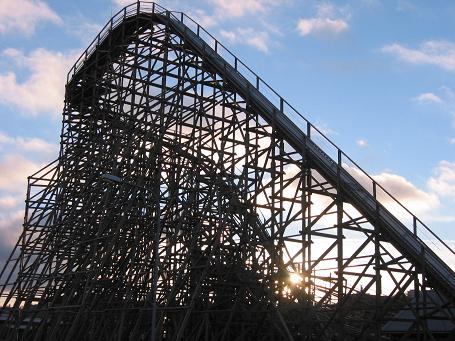
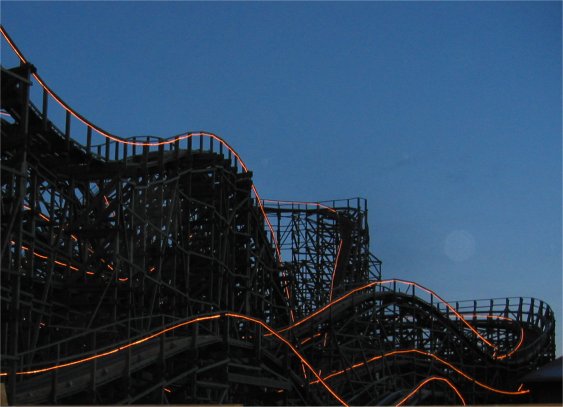
 The wooden coaster, Balder, on the east side of the
river dividing the Liseberg park, opened in 2003, and was voted the best
wooden coaster in the world.
The smooth ride is made possible by prefabricated glue laminated
track elements, introduced by Stengel, and used also in Balders larger predecessor, Colossos,
in Heidepark in Germany.
The strongest impression of the Balder ride - after experiencing 4g in
the first valley, is probably the sense of lightness, as if gravity were
somehow cancelled. It feels like it is very often "up" and more seldom
"down". Contributing to this impression are
several periods of floating air time, where
the track has a built-in "parabolic flight", letting the rider experience
near-weightlessness, as first realised by Werner Stengel in the
"Himalaya Bahn" in 1982.
Another feature contributing to the light feeling is that
track has relatively few
turns. The train runs like a shuttle in a loom, back and forth, and
before most turns, the train moves up, limiting the speed, and thereby
the g-forces in the turn.
The wooden coaster, Balder, on the east side of the
river dividing the Liseberg park, opened in 2003, and was voted the best
wooden coaster in the world.
The smooth ride is made possible by prefabricated glue laminated
track elements, introduced by Stengel, and used also in Balders larger predecessor, Colossos,
in Heidepark in Germany.
The strongest impression of the Balder ride - after experiencing 4g in
the first valley, is probably the sense of lightness, as if gravity were
somehow cancelled. It feels like it is very often "up" and more seldom
"down". Contributing to this impression are
several periods of floating air time, where
the track has a built-in "parabolic flight", letting the rider experience
near-weightlessness, as first realised by Werner Stengel in the
"Himalaya Bahn" in 1982.
Another feature contributing to the light feeling is that
track has relatively few
turns. The train runs like a shuttle in a loom, back and forth, and
before most turns, the train moves up, limiting the speed, and thereby
the g-forces in the turn.
Liseberg's position close to the center of Göteborg means that Balder has neighbours, who don't always appreciate happy roller coaster rider screams throughout the long summer evenings. Thus, in early 2004 a number of tunnels were added for damping the sound. In some ways the tunnels can be seen to enhance the ride, but the voters on the 2004 wooden coaster poll ranked it slightly lower, although still best in Europe with its seventh place.
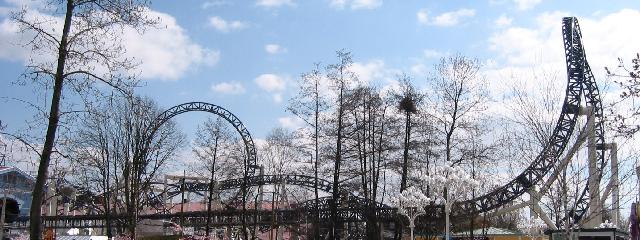
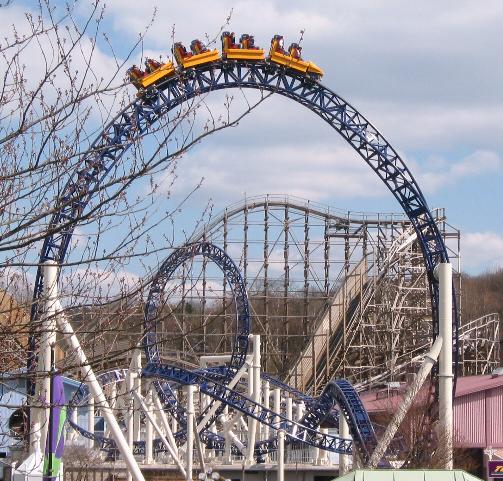 Slowly, the train goes up the lift hill, higher and higher, until it reaches the highest point. Down, up and down again. Over hills and through valleys and curves. That's the way it was in the classic wooden coaster "Bergbanan" that opened together with the Liseberg park for the world exhibition in 1923.
That's the way it was in Super8, the Liseberg Loop and in Hangover.
That's the way it is in Cirkusexpressen, Lisebergbanan and Balder - but not in Kanonen.
Are there no rules for coaster design?
Slowly, the train goes up the lift hill, higher and higher, until it reaches the highest point. Down, up and down again. Over hills and through valleys and curves. That's the way it was in the classic wooden coaster "Bergbanan" that opened together with the Liseberg park for the world exhibition in 1923.
That's the way it was in Super8, the Liseberg Loop and in Hangover.
That's the way it is in Cirkusexpressen, Lisebergbanan and Balder - but not in Kanonen.
Are there no rules for coaster design?
The hydraulic launch used in the Cannon, was developed a few years ago for Cedar Point, Ohio, aiming for the worlds highest and fastest roller coaster, the Top Thrill Dragster, which opened in 2003, where the train reaches 200 km/h in 4 seconds. The energy needed for the Cannon train to reach the top is stored before launch by compressing nitrogen to 300 times normal atmospheric pressure. During launch, the gas expands, forcing the hydraulic oil to reach the winch that catapults train and riders out of the station with sufficient speed to reach the top of the first hill. With this technique, high speed can be reached faster and in shorter time - an obvious choice for a park embedded in a city.
As we strap down for a ride in Kanonen, we prepare for an encounter with a few more of Werner Stengel's innovations. The shape of the loop, referred to as a clothoid, was introduced by Werner Stengel in 1975. While the upper part is a half circle, the lower part has a completely different shape. It is part of a "Cornu spiral", where the radius of curvature increases as you get closer to the ground. Why? In a circular loop, you would be exposed to 6g more than at the top. Further, during the entry to a circular loop, the sudden increase of forces on the body could lead to injury. The clothoid shape leads to a slower onset of lower forces on the body. Just before the loop, the rider has had a chance to experience weightlessness, where the track has a built-in "parabolic flight", as discussed above.
On the way back through the loop, the track runs around the "heartline" of the rider, rather than the rider travelling around the track. The rider moves with nearly constant velocity. The net force on the body is thus zero, with the force of gravity balanced by an opposing force from the train, although the direction of these forces in relation to the body changes during the motion. This form of screw was introduced by Werner Stengel in 1976, and leads to much lower strains on the body than both loops and more traditional cork screw elements in roller coasters.
The great arm of engineering reaches out to us all in every imaginable way. Engineering surrounds and astounds us. It constantly challenges what we have achieved and dares us to take the next step forward into the unknown. "E-factor" (entertainment) engineering can be compared to making the square peg fit into the round hole. Often, in themed environmens, corners are not square, structures may be intentionally crooked, and the traditional straightedge must be scrapped.From "The Fantastical Engineer - A Thrillseekers Guide to Careers in Theme Park Engineering" by Celeste Baine.